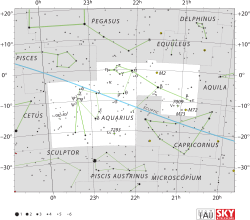Theta Aquarii

| |
| Observation data Epoch J2000 Equinox J2000 | |
|---|---|
| Constellation | Aquarius |
| Right ascension | 22h 16m 50.03635s[1] |
| Declination | –07° 46′ 59.8480″[1] |
| Apparent magnitude (V) | 4.175[2] |
| Characteristics | |
| Spectral type | G8 III–IV[3] |
| U−B color index | +0.818[2] |
| B−V color index | +0.983[2] |
| Astrometry | |
| Radial velocity (Rv) | –13.77 ± 0.17[4] km/s |
| Proper motion (μ) | RA: +118.80[1] mas/yr Dec.: –22.18[1] mas/yr |
| Parallax (π) | 17.40 ± 0.23[1] mas |
| Distance | 187 ± 2 ly (57.5 ± 0.8 pc) |
| Absolute magnitude (MV) | +0.23[3] |
| Details | |
| Mass | 2.39[5] to 2.78[3] M☉ |
| Radius | 12[4] R☉ |
| Luminosity | 72[4] to 83[3] L☉ |
| Surface gravity (log g) | 2.8[4] cgs |
| Temperature | 4,864[4] K |
| Metallicity [Fe/H] | +0.01[4] to +0.09[3] dex |
| Rotational velocity (v sin i) | 1.6[4] km/s |
| Age | 437[3] Myr |
| Other designations | |
Theta Aquarii (θ Aqr, θ Aquarii) is the bayer designation for a star in the equatorial constellation of Aquarius. It has the traditional name Ancha; Medieval Latin for "the haunch". Visible to the naked eye at apparent magnitude 4.175,[2] it is located at a distance of around 187 light-years (57 parsecs) from Earth.[1] Since it is near the ecliptic it can be occulted by the Moon, or very rarely by planets.
In Chinese, 泣 (Qì), meaning Weeping, refers to an asterism consisting of θ Aquarii and ρ Aquarii.[7] Consequently, θ Aquarii itself is known as 泣二 (Qì èr, English: the Second Star of Weeping.).[8] Possibly, the name Lei meaning tears (weeping) in Chinese, was appear from the Chinese name for this star[9]
Ancha belongs to the spectral class G8 with a luminosity class of III–IV suggesting that, at an age of 437[3] million years, this star is part way between the subgiant and giant stages of its evolution. Estimates of the star's mass range from 2.39[5] to 2.78[3] times the Sun's mass, with a radius of about 12[4] times that of the Sun. It is radiating from 72[4] to 83[3] times as much luminosity as the Sun from its enlarged outer envelope at an effective temperature of 4,864 K.[4] At this heat, the star glows with the yellow hue of a G-type star.[10]
References
- ↑ 1.0 1.1 1.2 1.3 1.4 1.5 van Leeuwen, F. (November 2007), "Validation of the new Hipparcos reduction", Astronomy and Astrophysics 474 (2): 653–664, arXiv:0708.1752, Bibcode:2007A&A...474..653V, doi:10.1051/0004-6361:20078357.
- ↑ 2.0 2.1 2.2 2.3 Gutierrez-Moreno, Adelina et al. (1966). "A System of photometric standards" 1. Publicaciones Universidad de Chile, Department de Astronomy. pp. 1–17. Bibcode:1966PDAUC...1....1G.
- ↑ 3.0 3.1 3.2 3.3 3.4 3.5 3.6 3.7 3.8 Takeda, Yoichi et al. (August 2008), "Stellar Parameters and Elemental Abundances of Late-G Giants", Publications of the Astronomical Society of Japan 60 (4): 781–802, arXiv:0805.2434, Bibcode:2008PASJ...60..781T, doi:10.1093/pasj/60.4.781.
- ↑ 4.0 4.1 4.2 4.3 4.4 4.5 4.6 4.7 4.8 4.9 Massarotti, Alessandro et al. (January 2008), "Rotational and Radial Velocities for a Sample of 761 HIPPARCOS Giants and the Role of Binarity", The Astronomical Journal 135 (1): 209–231, Bibcode:2008AJ....135..209M, doi:10.1088/0004-6256/135/1/209.
- ↑ 5.0 5.1 Pizzolato, N.; Maggio, A.; Sciortino, S. (September 2000), "Evolution of X-ray activity of 1-3 Msun late-type stars in early post-main-sequence phases", Astronomy and Astrophysics 361: 614–628, Bibcode:2000A&A...361..614P.
- ↑ "tet Aqr -- Star", SIMBAD Astronomical Object Database (Centre de Données astronomiques de Strasbourg), retrieved 2012-06-30.
- ↑ (Chinese) 中國星座神話, written by 陳久金. Published by 台灣書房出版有限公司, 2005, ISBN 978-986-7332-25-7.
- ↑ (Chinese) 香港太空館 - 研究資源 - 亮星中英對照表, Hong Kong Space Museum. Accessed on line November 23, 2010.
- ↑ Richard Hinckley Allen: Star Names — Their Lore and Meaning: Aquarius
- ↑ "The Colour of Stars", Australia Telescope, Outreach and Education (Commonwealth Scientific and Industrial Research Organisation), December 21, 2004, retrieved 2012-01-16.
External links
| ||||||||||||||||||||||||||||||||||||||||||||||||||||||||||||||